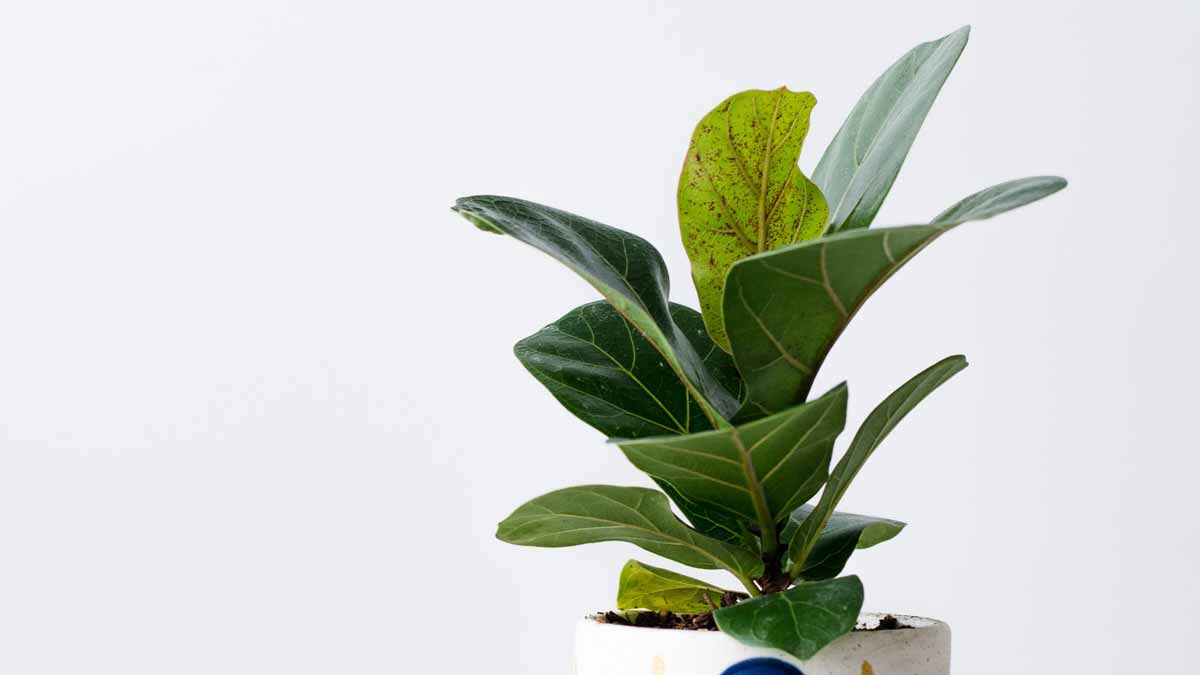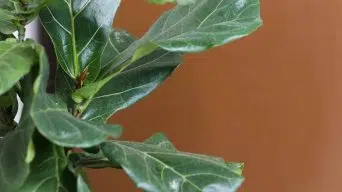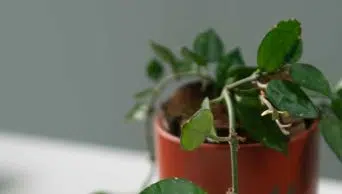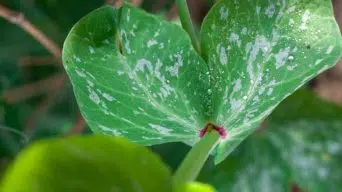Black spots on ficus leaves are commonly caused by overwatering, fungal diseases, or bacterial leaf spot. To address this, adjust watering habits, apply fungicides, and trim affected areas for a healthier ficus.
Ficus plants are popular houseplants because they are relatively easy to care for.
However, even the most experienced gardeners can run into problems with their plants from time to time.
One common issue that ficus owners face is black spots on the leaves of their plants.
In this article, we’ll discuss seven common causes of black spots on ficus leaves and how to solve them.
What Causes Black Spots on Ficus Leaves and How Can You Fix It?
A few different things can cause black spots on ficus leaves.
Here are the most common causes and what you can do about them:
1. Overwatering
Overwatering is one of the leading causes of black spots on ficus leaves.
When the plant is overwatered, the roots cannot take in oxygen from the soil.
This can lead to several problems, including root rot, fungal growth, and leaf drop.
Overwatering is usually caused by too much water, insufficient drainage, or a combination of the two.
Other common signs of overwatering include:
- Wilting leaves
- Yellowing leaves
- White spots on leaves
- Mushy or soft leaves or stems
- Rotting roots
- Soil that is constantly moist or soggy
How To Fix It
If you think your plant is being overwatered, you first should stop watering it for a while.
Let the soil dry out completely before you water your plant again.
Check your pot’s drainage to ensure that the water is draining correctly.
If the drainage is poor, repot your plant in a pot with better drainage.
Ensure you are only watering your plant when the soil is dry and only giving it enough water to moisten it.
2. Fungal Disease
Fungal diseases are another leading cause of black spots on ficus leaves.
Common fungal diseases that affect ficus trees include anthracnose, black spot, sooty mold, and leaf spot.
These diseases are often caused by overwatering, as wet leaves provide the perfect environment for fungi to grow.
The fungi thrive in warm, humid conditions and can spread quickly from one plant to another.
Anthracnose
Anthracnose is a fungal disease that affects many different types of plants, including ficus.
It is characterized by black or brown spots on the plant’s leaves, stems, and fruit.
A yellow halo usually surrounds the spots.
Anthracnose can cause the leaves to curl up and drop off the plant.
Black Spot Fungus
Black spot is another fungal disease that affects ficus plants.
The fungus causes black spots to form on the leaves of the plant.
The spots are usually circular and have a yellow halo around them.
The spots can eventually cause the leaves to turn yellow and fall off the plant.
Sooty Mold
Sooty mold is a fungus that often grows on the leaves of plants infested with aphids or scale insects.
The insects secrete a sticky substance called honeydew, which the sooty mold uses as a food source.
The mold can cause the plant leaves to turn black or brown.
If the infestation is severe, it can cause the leaves to drop off the plant.
Fungal Leaf Spot
Leaf spot is another type of fungal disease that can cause black spots on ficus leaves.
The fungus causes small, circular spots to form on the leaves.
The spots are usually black or brown and may have a yellow halo around them.
Leaf spot can also cause the leaves to turn yellow and drop
How To Fix It
If you think your ficus tree has a fungal disease, the first step is to remove any affected leaves.
Throw them away in a plastic bag, so the fungus doesn’t spread.
Next, you’ll need to improve the soil drainage and ensure the plant is not getting too much water.
Allow the top inch of soil to dry before watering the plant again.
Improving the air circulation around the plant can also help prevent fungal diseases.
Make sure the plant has enough light and space to breathe.
You can treat the plant with a natural fungicide if the problem persists.
Neem oil, for example, is a natural fungicide that can be effective against many types of fungi.
You can also try using a commercial fungicide, but make sure to follow the instructions carefully.
3. Bacterial Leaf Spot
Bacterial leaf spot is another common problem that can cause black spots on ficus leaves.
A variety of different bacteria causes this disease.
These bacteria enter the plant through wounds in the leaves or stem.
Once inside, they multiply rapidly and cause the tissue around them to die.
This results in the formation of tiny, black spots on the leaves.
Other common symptoms of the bacterial leaf spot disease include:
- Yellowing or browning of the leaves
- Leaves dropping off the plant
- Stunted growth
How To Fix It
If you think your plant has a bacterial leaf spot, you should first isolate it from other plants.
This will prevent the disease from spreading.
Next, you need to remove all the infected leaves.
Be sure to dispose of them so that they won’t spread the disease to other plants.
After that, you can treat the plant with a copper-based fungicide.
This will help kill the bacteria and prevent further spread of the disease.
You should also ensure to keep your plant healthy by giving it the proper care.
This includes watering it regularly, fertilizing it, and ensuring it gets enough light.
A healthy plant is better able to resist diseases like bacterial leaf spot.
4. Pests
Pests are another common problem that can cause black spots on ficus leaves.
Aphids, scale insects, whiteflies, and mealybugs are common pests that can infest ficus plants.
Aphids
Aphids are small, soft-bodied insects that are typically green, although they can also be black, brown, or yellow.
Aphids feed by piercing the leaves of plants with their long mouths and sucking out the sap.
This feeding can cause black spots on ficus leaves and curling, yellowing, or stunted growth.
If you think your ficus has aphids, inspect the undersides of the leaves for small, pear-shaped insects.
You may also see a sticky substance on the leaves: honeydew that the aphids excrete.
To get rid of aphids, start by spraying the ficus with water to remove any on the leaves’ surface.
Then, apply an insecticidal soap or neem oil to kill any remaining aphids.
You may need to repeat this treatment every few days for a week or two to eliminate the aphids.
Scale Insects
Scale insects are another type of pests that can infest ficus plants.
These pests are small, flat, and circular in shape.
They are usually brown or black and feed on the sap of plants.
Scale insects can cause black spots on ficus leaves and other types of damage such as leaf yellowing and stunted growth.
If you think your ficus has scale insects, look for small, brown, or black bumps on the undersides of the leaves.
These bumps are actually the insects themselves.
You can try horticultural oil or insecticidal soap to get rid of scale insects.
These products must be applied directly to the scale insects to be effective.
You can manually remove them from the plant with a cotton swab dipped in rubbing alcohol.
Whiteflies
Whiteflies are small, winged insects that congregate on the undersides of leaves.
They feed by sucking sap from the plant, which can cause yellowing and wilting of the leaves.
Whiteflies also secrete a sticky substance called honeydew, which can attract sooty mold and other fungi.
If you think you have whiteflies, look for winged adults or nymphs on the undersides of leaves.
You may also see honeydew or sooty mold on the leaves or stems.
To get rid of whiteflies, spray the plant with water to knock them off.
Then, treat the plant with insecticidal soap or neem oil.
You can also release beneficial insects, like ladybugs or green lacewings, into your garden to eat the whiteflies.
Mealybugs
Mealybugs are one of the most common houseplant pests and love ficus plants.
Mealybugs look like tiny white cotton balls and suck the sap out of plants.
Mealybugs can cause black spots on ficus leaves and other problems such as yellowing leaves and stunted growth.
To get rid of mealybugs, start by wiping them off with a damp cloth.
You can also try using a cotton swab dipped in alcohol to kill them.
You can use insecticide soap or neem oil if that doesn’t work.
5. Phosphorus Deficiency
If your ficus has black spots on the leaves and the leaves are also starting to curl, this could be a sign of phosphorus deficiency.
Phosphorus is an essential plant nutrient, helping with root growth, flower production, and seed development.
A lack of phosphorus can be caused by several factors, including:
- Cold weather
- Poor soil quality
- Compact soil
- Too much water
- Soil pH that is too low
How To Fix It
If you think your ficus has a phosphorus deficiency, you can try to correct it by adding bone meal or rock phosphate to the soil.
You can also adjust the pH of the soil to make it more acidic.
It’s also essential to ensure that your ficus is getting the right amount of water.
Let the soil dry out slightly between waterings to prevent root rot.
And, if you live in a cold climate, protect your ficus from the cold weather by moving it indoors or covering it with a frost blanket.
6. Frost Damage
Frost damage is another possible cause of black spots on ficus leaves.
When the temperature drops below freezing, the water in the cells of plants can freeze, causing the cells to burst.
This can damage the leaves, stems, and flowers of plants.
Frost damage often appears as brown or black spots on the leaves.
How To Fix It
If you think your ficus has frost damage, there’s not much you can do to repair the damage.
However, you can prevent frost damage by covering your plant with a frost blanket when the temperature is expected to drop below freezing.
If possible, you can also move your plant indoors or to a warmer location.
7. Natural Aging
Last but not least, black spots on ficus leaves can also be a sign of natural aging.
As plants age, their leaves can turn yellow or brown and may develop black spots.
This is especially common in older leaves that have been exposed to the sun and wind for a long time.
If the black spots are only on a few older leaves, and the rest of the plant looks healthy, there’s no need to worry.
The black spots won’t harm the plant, and the old leaves will eventually fall off.
How To Fix It
There’s no need to do anything to fix the black spots on the leaves of your ficus.
The plant will eventually shed the old leaves and grow new ones.
To help the process, you can remove the affected leaves by gently pulling them off or snipping them off with pruning shears.
How To Prevent Black Spots On Ficus Leaves
Black spots on ficus leaves can be unsightly and detrimental to your plant’s health.
While there are several potential causes of black leaf spots, fortunately, you can also do several things to prevent this problem.
Here are some tips for preventing black spots on ficus leaves:
1. Make Sure Your Plant Is Getting Enough Light
Ficus plants need bright, indirect light to thrive. If your plant is not getting enough light, it may be more susceptible to leaf spot diseases.
2. Water Your Plant Properly
Overwatering can lead to fungal diseases that can cause black spots on leaves.
Make sure to water your ficus tree only when the soil is dry to the touch.
3. Avoid Wetting the Leaves When You Water
Wetting the leaves of your ficus tree can promote fungal growth and lead to leaf spot diseases.
Instead, water the soil directly to avoid wetting the leaves.
4. Use a Well-draining Potting Mix
If the potting mix you’re using doesn’t drain well, it can lead to root rot, which can cause black spots on the leaves.
Choose a potting mix that has good drainage to help prevent this problem.
5. Improve Air Circulation Around Your Plant
Good air circulation helps to prevent fungal diseases from developing.
Place your plant in a well-ventilated area, and avoid placing it too close to other plants or objects.
6. Keep the Leaves Clean
Dirty leaves are more likely to develop fungal diseases.
Regularly wipe the leaves of your ficus plant with a damp cloth to remove dust and dirt and keep your indoor plant leaves shiny.
7. Inspect Your Plant Regularly
Check your plant regularly for signs of pests or diseases.
If you see any black spots on the leaves, remove them immediately.
8. Quarantine New Plants
When you bring a new plant home, it’s essential to quarantine it before adding it to your collection.
This helps to prevent the spread of pests and diseases.
Keep the new plant in a separate room for a few weeks, and inspect it carefully for signs of problems.
9. Treat Pests and Diseases Promptly
If you notice pests or diseases on your plant, treating them immediately is essential.
The sooner you catch the problem, the easier it will be to treat.
10. Dispose of Affected Leaves Properly
If you remove any leaves that have black spots, make sure to dispose of them properly.
Don’t compost them, as this can spread the disease to other plants.
Instead, throw them away in the trash.
Final Thoughts
Black spots on ficus leaves can be caused by various factors, from pests to disease.
However, in most cases, these black spots are nothing to worry about and can be easily treated.
If you notice black spots on your ficus leaves, look closely at the plant and identify the cause.
Doing this lets, you determine the best way to treat the issue and get your ficus back to looking its best.







